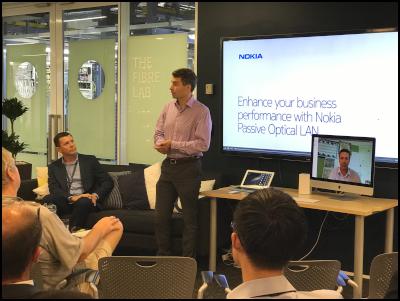
Thanks to the
government-sponsored UFB roll-out most New Zealand
businesses are now on the fibre network. Fibre delivers
gigabit internet to offices, factories and other business
buildings.
It means better, more reliable communications. Done well, fibre delivers productivity gains. In business, network speed is the killer app.
Yet for many companies, fibre stops at the door. Or, more likely, a termination point somewhere in the building. From there most connections are copper.
Passive Optical Lan, or POL, is the modern way
to build local area networks. POL uses fibre to move data
around a building. It is, at core, a local version of the
UFB network technology.
Passive is good
A group of homes or other buildings on the UFB network share a single fibre line. The single fibre is split using a device called a passive splitter. It's called passive because there's no switch involved. The main fibre line divides into a number of lines; one for each building.
You may hear fibre network people talk of GPON, that's a Gigabit Passive Optical Network. A Passive Optical Lan divides fibre lines in the same way.
Passive is the important word here. In a copper network you need electrical power. That's active; the opposite of passive. Data signals in a copper cable are electrical currents. You also need power to drive the copper switches.
Fibre data signals are light waves.
Power is needed at each end of the connection. There is no
need for power at each step of the journey. That means cost
savings. It also means there's no electricity warming things
up, so you don't need air conditioning. It also means there
is less to break.
Speed
The most obvious benefit of moving to fibre for internal networking is that it is fast. In practice this is less important than other considerations.
In most business buildings the internal network still relies on copper, usually Ethernet cables.
That's OK from a performance point of view. Gigabit Ethernet, even 10 GigaBit Ethernet, can move data around fast enough for every practical office application over short distances.
Moving data is harder in a large
office spread over many floors or on a campus-like site. But
for most office purposes copper is still fast enough for
most networking. That doesn't make it ideal.
Cost, complexity, compact
POL's other benefits are more compelling. It is much cheaper to install and operate. At a TechWeek function held at the Chorus Lab, Peter Vandaele from Nokia said the capital expenditure for a POL is about half that for a copper network.
Underlining this point, Alan Warne, an IT project manager working for Environment Canterbury says the organisation saved more than $100,000 when it installed New Zealand's first POL. He says: "We got a quote of $185,000 for a copper network. The fibre we used cost $82,000".
Vandaele says it's not just capital
savings on the install. Fibre needs less physical cable and
power consumption is up to 75 percent less per connection.
The hardware takes up much less space, in many office
buildings this means enough room for extra desks on each
floor.
Impact on building design
Warne says his one regret about installing POL at Environment Canterbury is that the organisation decided to use the technology after the building was constructed. An early decision would have meant a different, more efficient building design.
POL is popular with hotels, especially upmarket ones. Vandaele says the saved space means they can often add an extra room to each floor.
Fibre doesn't
degrade like copper. It needs less maintenance and, more
important for many companies, it doesn't require skilled
technicians to reconfigure. In most cases people can plug or
unplug connectors as needed.
Passive optical lan promises easy care networks
Because of lower power requirements and the elimination of constant heating and cooling, fibre networks are less prone to faults. If something does go wrong, it is far easier to find the fault.
There is also greater resilience. Warne tells of a test where he deliberately cut one incoming fibre line during a video conference call. The network switched over to another line so fast that participants were not aware of the event.
So, if POL is this good, why isn't it everywhere? The first reason is that companies don't upgrade networks as often as, say, servers. The technology is still relatively new. While it has many benefits, few companies are going to rip out their existing copper networks for a fibre replacement. However, when the next upgrade comes many will look at POL then.
Passive Optical Lan means fibre to the desktop was first posted at billbennett.co.nz.



 Binoy Kampmark: Detained Without Charge - Eleven Yemenis Leave Guantánamo
Binoy Kampmark: Detained Without Charge - Eleven Yemenis Leave Guantánamo Ramzy Baroud: The War Criminal 'Victim' - Netanyahu’s Inevitable Fate
Ramzy Baroud: The War Criminal 'Victim' - Netanyahu’s Inevitable Fate Martin LeFevre - Meditations: From Symbolic Consciousness To Insight Consciousness
Martin LeFevre - Meditations: From Symbolic Consciousness To Insight Consciousness Binoy Kampmark: Arresting And Killing Greenies - Targeting Climate Change Protests
Binoy Kampmark: Arresting And Killing Greenies - Targeting Climate Change Protests Ian Powell: Welcome Puberty Blockers Report But Beware Derailing Transphobia
Ian Powell: Welcome Puberty Blockers Report But Beware Derailing Transphobia Gordon Campbell: On Why We Can’t Survive Two More Years Of This
Gordon Campbell: On Why We Can’t Survive Two More Years Of This